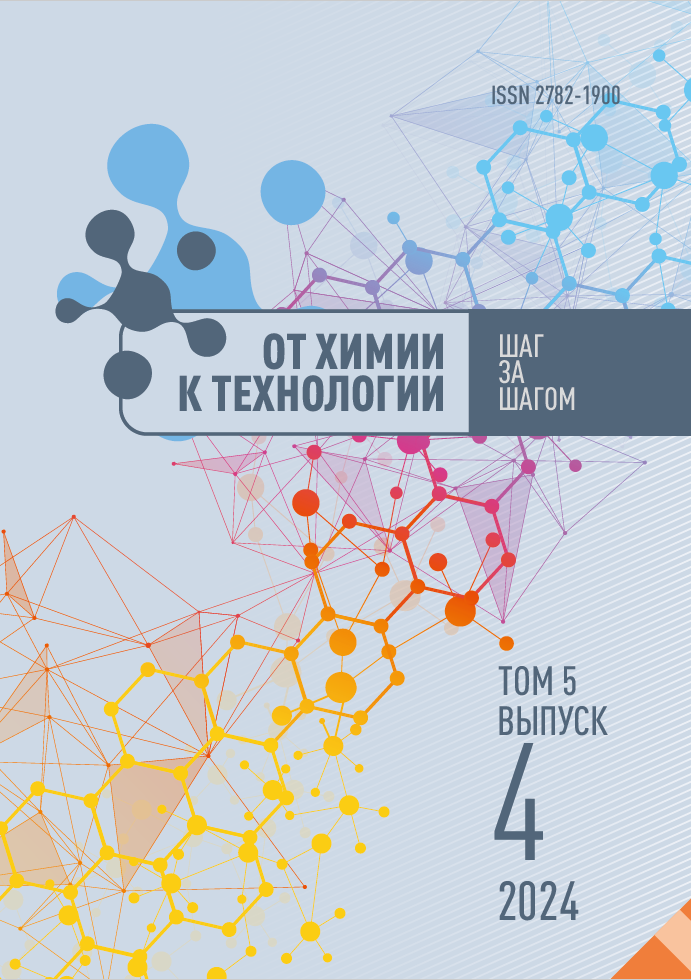Иваново, Ивановская область, Россия
Иваново, Ивановская область, Россия
Иваново, Ивановская область, Россия
Иваново, Ивановская область, Россия
Иваново, Ивановская область, Россия
УДК 544.476.2 Каталитический центр. Активный центр. Частота оборота (катализатора)
The paper investigates the activity of a skeletal nickel catalyst upon its partial controlled deactivation in the liquid-phase hydrogenation reaction of sodium 4 nitrophenolate. The reaction proceeds in aqueous solutions of sodium hydroxide at 303 K and atmospheric hydrogen pressure in a batch reactor. An aqueous solution of sodium sulphide with pH equal to the hydrogen value of the solvent in the reactor was a deactivating agent. We used the Bartholomew C.G. technique to assess the nature of the catalyst deactivation. Using this technique, we determined the number of active nickel atoms blocked by a single sulfide ion and proposed TONdeact as a parameter to show the resistance of the catalyst to deactivation. The authors proposed an original method for calculating TONdeact values for catalytic systems of liquid-phase hydrogenation under conditions of deactivation by catalytic poisons. Indeed, the initial decrease in activity in 0.01 M NaOH concerns with a decrease in the catalytic properties of the active centres. Subsequently, the activity of individual centres remains stable. However, the decrease in the overall activity of the catalyst occurs due to their proportional blocking. This explains the selective character of deactivation according to Bartholomew C.G. The poison proportionally removes active centres from the reaction zone in 0.1 M NaOH. This causes a non-selective character of poisoning. The kinetic relationships depend on the accumulation of different intermediates on the catalyst surface at different concentrations of the introduced sulfide ion. Therefore, the reaction rate and absolute activity can increase slightly at small amounts of catalytic poison. However, the activity of the catalyst is irretrievably lost with further increase in the concentration of sulfide ion.
skeletal nickel catalyst, sodium 4 nitrophenolate, catalyst deactivation, liquid-phase hydrogenation, catalytic poison, TONdeact, TON
1. Kunin A.V., Ilyin A.A., Morozov L.N., Smirnov N.N., Nikiforova T.E., Prozorov D.A., Rumyantsev R.N., Afineevskiy A.V, Borisova O.A., Grishin I.S., Veres K.A., Kurnikova A.A., Gabrin V.A., Gordina N.E. Catalysts and adsorbents for conversion of natural gas, fertilizers production, purification of technological liquids // ChemChemTech. 2023. V. 66, No. 7. P. 132-150. DOIhttps://doi.org/10.6060/ivkkt.20236607.6849j.
2. Afineevsky A.V., Prozorov D.A., Osadchaya T.Yu., Gordina N.E. Adsorption-catalytic deformation in the synthesis of hydrogenation catalysts // Protection of Metals and Physical Chemistry of Surfaces. 2023. V. 59, No. 1. P. 1-6. DOIhttps://doi.org/10.31857/S0044185622700012.
3. Cherdantsev Yu.P., Chernov I.P., Tyurin Yu.I. Methods of investigation of metal-hydrogen systems. Tomsk: ‘Izd-wo: TPU’, 2008. 286 p. (In Russian).
4. Lukin M.V., Prozorov D.A., Ulitin M.V., Vdovin Yu.A. Controlled deactivation of a skeletal nickel catalyst with sodium silfide in liquid-phase hydrogenation reactions // Kinetics and Catalysis. 2013. V. 54, No. 4. P. 412 419. DOI:https://doi.org/10.1134/S0023158413040101.
5. Klyachko A.L. Teplota adsorbcii na poverhnosti s diskretnoj neodnorodnost'yu [Heat of adsorption on a surface with discrete heterogeneity] // Kinetika i kataliz [Kinetics and Catalysis]. 1978. Vol. 19, No. 5. P. 1218 1223. (In Russian).
6. Ostrovsky N.M. Kinetics of catalyst deactivation: mathematical models and their application. Moscow: ‘Nauka’, 2001. 335 p. (In Russian).
7. Sokolsky D.V. Hydrogenation in solutions. Alma-Ata: ‘Nauka’, 1979. 436 p. (In Russian).
8. Anderson J. Structure of metallic catalysts. M.: Mir, 1978. 485 p. (In Russian).
9. Pat. RF 2669201 / Prozorov D.A., Afineevsky A.V., Nikitin K.A., Sukhachev Y.P., Chelysheva M.D. Publ. 2018.
10. Shmonina V.P., Seredenko V.V., Kulazhanov K.S. Vliyanie zamestitelej na kinetiku vosstanovleniya nitrogruppy v aromaticheskih soedineniyah v usloviyah geterogenno-kataliticheskogo prevrashcheniya [Influence of substituents on the kinetics of nitro group reduction in aromatic compounds under conditions of heterogeneous-catalytic transformation] // Zhurn. obshchej himii [Journal of General Chemistry]. 1974. Vol. 4. Pp. 346-355. (In Russian).
11. Gelder E.A., Jackson S.D., Lok C.M. The hydrogenation of nitrobenzene to aniline: a new mechanism // Chem. Commun. 2005. No. 4. P. 522-524.
12. Afineevsky A.V., Prozorov D.A., Osadchaya T.Yu., Gordina N.E. Effect of adsorption-catalytic deformation and partial deactivation on the determination of the absolute activity of a liquid phase hydrogenation catalyst // Fine Chemical Technologies. 2023. V. 18, No. 4. P. 341–354. DOI:https://doi.org/10.32362/2410-6593-2023-18-4-341-354.
13. Prozorov D.A., Afineevsky A.V., Knyazev A.V., Lukin M.V., Osadchaya T.Y., Rumyantsev R.N. Catalytic properties and deactivation of skeletal nickel in liquid-phase hydrogenation reactions. Kazan: ‘Buk’, 2018. 316 p. (In Russian).
14. Koifman O.I., Barbov A.V., Gostikin V.P., Komarov A.A., Lefedova O.V., Merkin A.A., Nemtseva M.P., Romanenko Y.E., Ulitin M.V., Sharonov N.Y. Theory and practice of processes of liquid-phase hydrogenation of substituted nitrobenzenes. Moscow: Krasand. 2016. 528 p. (In Russian).







